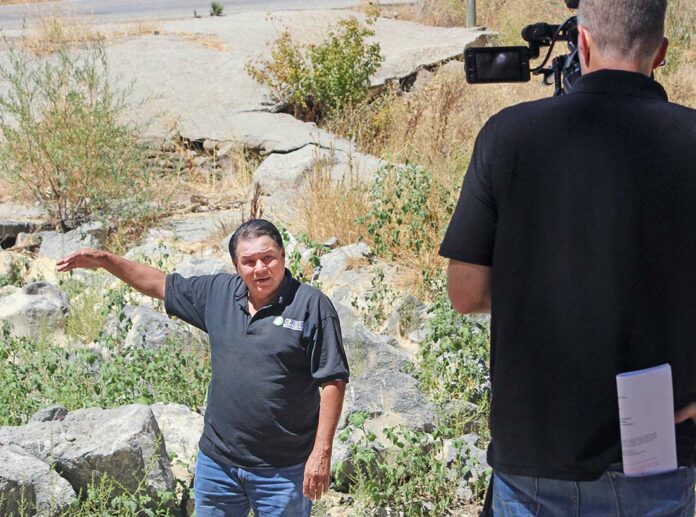
Herman Garcia and his crew of volunteers’ mission to clean up the watershed and save steelhead is well-chronicled in the local region.
But now, the story of Gilroy-based Coastal Habitat Education and Environmental Restoration (CHEER) is going national.
A crew from the National Oceanic and Atmospheric Administration’s Fisheries division visited Gilroy on Aug. 22 to film Garcia as he explained how he went from a star poker player known as “The California Kid” to becoming one of the state’s most outspoken advocates for watershed reclamation and fish recovery.
Charlotte Ambrose, NOAA Fisheries’ California programs coordinator, said the division provides oversight of conservation and recovery efforts of salmon and steelhead. The film project is an initiative to highlight stories of people and organizations across California, Washington, Oregon and Idaho who are working to save these fish from extinction.
Ambrose said NOAA Fisheries plans on interviewing about 20 individuals and organizations as part of its year-long project, of which Garcia was the first to be filmed.
“Herman is our first for obvious reasons,” she said. “He helps support NOAA’s mission to save salmon and steelhead, works with the homeless, educates underserved communities and builds a community-supported steelhead restoration. If not for Herman and CHEER, we wouldn’t have steelhead in Gilroy.”
Katie Love, a Pathways intern for NOAA Fisheries and project manager for the film project, said the work provides a “counter narrative” to what is called “salmon fatigue.”
For decades, countless resources, time and funds have been dedicated to salmon recovery, and people want to see the results, she said.
“Maybe they’re questioning whether it’s worth that time and money, and we want to say that yes, it certainly is,” Love said. “Here are a bunch of diverse stakeholders who are impacting salmon populations and are also impacted by salmon populations.”
She added that some of the interviewees will include ranchers, artists, chefs and fishers.
“It’s a really diverse group of people who will collectively paint a story of a successful future for salmon,” she said.
Since 2006, CHEER has worked to reclaim and restore watersheds decimated by toxins and pollution, cleaning up more than 1,300 square miles from Morgan Hill down into San Benito County and Watsonville, taking on the never-ending challenge of removing garbage from the rivers and creeks before it makes its way into the Monterey Bay. The work has produced what Garcia described as “best practices,” which yields tangible results.
Garcia is quick to share numbers from the group’s work. In 2006, CHEER saved 120 fish, he said, and that number jumped up to 1,482 the second year.
He added that the group has no problem clearing out thousands of pounds of garbage daily from the watershed, and since it began, CHEER has removed 60 vehicles, five boats and two motorcycles from the waterways.
The film crew began the day on Aug. 22 scouting out locations around Gilroy to conduct the interview. They settled on Silva’s Crossing at Christmas Hill Park, stationed in the currently dry Uvas Creek.
After the interview wrapped up, Garcia, 75, said he was “flattered” to be chosen for NOAA Fisheries’ project.
“It’s necessary to have this type of film that is educational and can move the process along with the general public to help us,” he said. “We need help. We can’t do it by ourselves.”
It was a point Garcia made while he was being filmed, stressing that everybody can chip in to ensure that garbage doesn’t end up flowing into rivers, and eventually, the massive garbage patch in the Pacific Ocean.
“Guess what, America,” he said on camera. “We don’t have to spend a dollar to fix this. If everybody does their part, picking up a plastic bottle or a piece of paper, instead of stepping over it, we can fix this.”
The interviews, once all are completed, will be posted on NOAA Fisheries’ website for viewing.
“We hope that the stories inspire others to continue these legacies and bring awareness to no matter who you are, no matter how old you are, no matter where you are, that all of us have a role to protect and preserve our watersheds,” Ambrose said.














